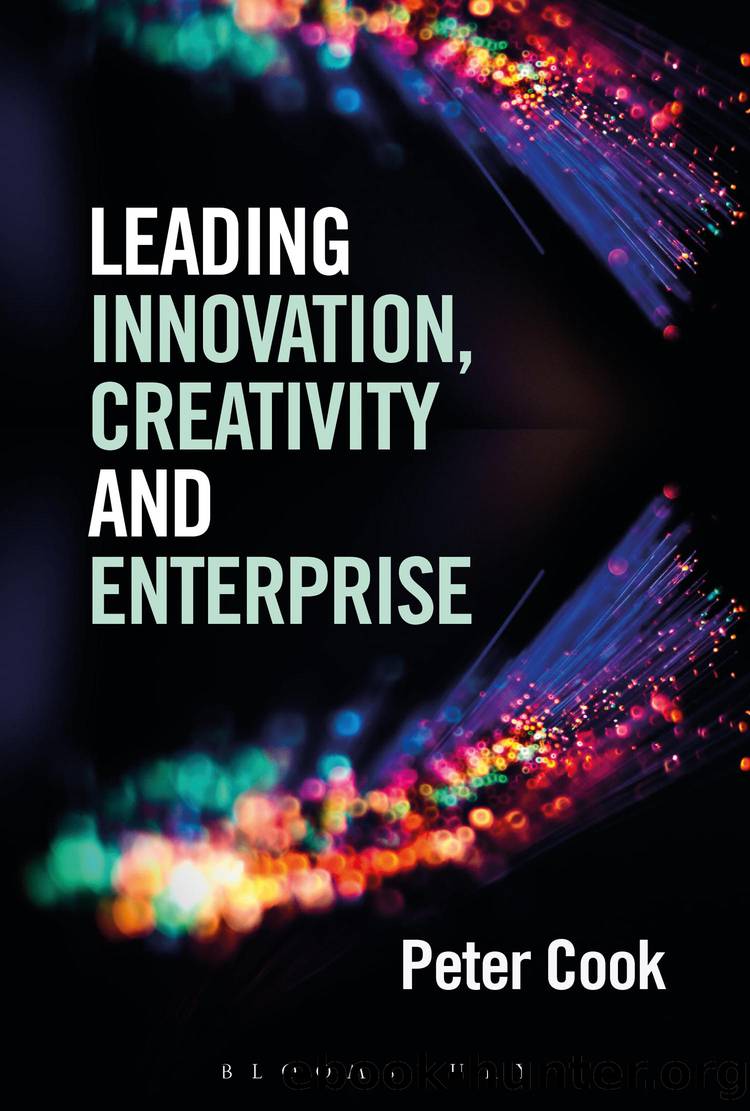Leading Innovation, Creativity and Enterprise by Cook Peter;

Author:Cook, Peter; [Cook, Peter]
Language: eng
Format: epub
Publisher: Bloomsbury Publishing Plc
Published: 2016-02-03T00:00:00+00:00
From the abacus to calculus and papyrus
The word innovation has been devalued by its use throughout society as an approximation for the word ânewâ. It is therefore useful to start with some definitions of what innovation is.
Strategic â This includes building and changing a brand, developing the companyâs competence base or unique position, restructuring the company so that it maintains competitive edge. An example would be the Automobile Associationâs repositioning as the â4th emergency serviceâ in the UK, which added 2.5 million customers (nearly 20%) to their business. The idea for this change came from one of the staff, which illustrates that strategic thinking can come from anywhere in an enterprise. We examine Innocent Drinks as a supreme example of innovation in branding later on.
Product/Service â This is the exploitation of novel ideas to deliver something of value to the market place, or the reconfiguration of an existing product or service so that it is more in tune with market demand. Classic examples of product innovation include the 3M Post-it Note⢠(1977), Papyrus (4000 BC), the Fender Stratocaster (1954), the analogue computer (150 BC) the Bic pen (1950), the bra (fifteenth century), the abacus (500 BC), the Macintosh (1984). Later on in this chapter, we study Metro Bank as an outstanding example of service innovation in a tired and traditional industry.
Process â This is basically a new way to do old things. It is often about incremental or radical change management internally within an enterprise and is often visible through lean programmes and their ilk. Other examples include shortening the distance or number of steps between the enterprise and its customers. In a busy world, shorter and smarter processes have the potential to give your enterprise sustainable competitive advantage. Just think how Amazon captured the worldâs attention with the âone click and youâre doneâ promise. This is a lesson yet to be learned in public services where the Internet has tended to extend the distance between the public and the public service. This is often due to the transference of paper-based systems to computer-based ones without a fundamental review of what is really needed. Many times, additional checks and balances are added. Public services are clearly in need of some mathematical creativity, especially the minus and divide operators.
Another way of looking at innovation is to examine it using the reversal technique we examined in Chapter 4, by looking from the end point backwards, at how we measure innovation. We live in an age where lots of things can be quantified and it seems almost irresistible to then measure all the things that can be measured. Yet it is a fundamental mistake to assume that those things that cannot be measured easily are not important to the long-term future of businesses. This is well illustrated by what US Secretary of State (1961â1968) Robert McNamara said in what came to be known as the âMcNamara fallacyâ:
Download
This site does not store any files on its server. We only index and link to content provided by other sites. Please contact the content providers to delete copyright contents if any and email us, we'll remove relevant links or contents immediately.
Big Magic: Creative Living Beyond Fear by Elizabeth Gilbert(4727)
On Writing A Memoir of the Craft by Stephen King(4216)
Paper Towns by Green John(4171)
The Doodle Revolution by Sunni Brown(4045)
Hyperfocus by Chris Bailey(3272)
Evolve Your Brain by Joe Dispenza(3051)
Unlabel: Selling You Without Selling Out by Marc Ecko(2984)
The Red Files by Lee Winter(2917)
The Power of Mindful Learning by Ellen J. Langer(2711)
Draw Your Day by Samantha Dion Baker(2708)
The Art of Dramatic Writing: Its Basis in the Creative Interpretation of Human Motives by Egri Lajos(2414)
The War Of Art by Steven Pressfield(2402)
How to be More Interesting by Edward De Bono(2357)
Applied Empathy by Michael Ventura(2331)
The 46 Rules of Genius: An Innovator's Guide to Creativity (Voices That Matter) by Marty Neumeier(2313)
Why I Am Not a Feminist by Jessa Crispin(2240)
How to Stop Worrying and Start Living by Dale Carnegie(2219)
You Are Not So Smart by David McRaney(2181)
Keep Going by Austin Kleon(2166)
